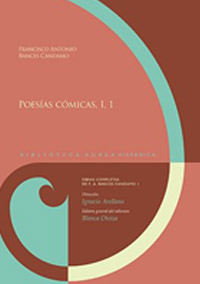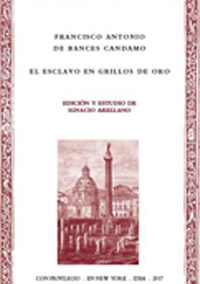Bances Candamo

Francisco Antonio de Bances Candamo has been defined as a "borderline writer" or bridge writer between the 17th and 18th centuries , as some authors argue that sample has a humanistic concern more typical of the Enlightenment and the 18th century than of the 17th. And yet this poet is at the same time a late son of Calderón, perhaps the best of the "minor poets" and a man deeply rooted in the seventeenth century in which he lived. Despite these characteristics, Bances has also been quite misunderstood by critics until the last third of the 20th century, when the study of his work began with critics such as Moir, Rozas, Suárez, Arellano, García Castañón, Sabik...
This website aims to be an instrument of financial aid for researchers of late 17th and early 18th century theatre and especially of the figure of Francisco Antonio de Bances Candamo. In principle, we publish here a general primarybibliography of Bances Candamo's theatre, where the curious reader will be able to access a tool that will facilitate the work of our team and of all those interested in fin-de-siècle theatre. Our goal is to provide each entrance with a useful commentary that defines the main contributions and novelties of this file. We think that the task is difficult because a bibliography of this subject is, by definition, endless and incomplete. Incomplete because critics will continue, and we will continue, to publish articles on Bances Candamo's literature and to discover novelties in his life and theatre that will not appear here. And incomplete, because despite our efforts we will always have left behind essential bibliographical references for a correct understanding of the figure and work of Bances Candamo. We apologise to all of them.
On the other hand, we considered that this bibliography should be published on the network network so that all scholars interested in fin-de-siècle theatre could have quick access to it. We live in a globalised world with immediate access to information and we wanted to expose this tool to its maximum dissemination so that scholars and critics could have quick access to it. We believe in a network based on the exchange of materials and ideas, which serves to communicate achievements and difficulties and which allows people and teams from research to be put on contact , however distant they may be.
But this website will not be limited to the dissemination of this critique. bibliography criticism. On this page, we will also be uploading the result of our research: our articles and critical texts (these without the critical apparatus, without introductions or notes) so that they reach as many users as possible issue . We will complement it with images, news, conference announcements, etc.
It only remains for us to express our thanks, which we will leave until last, but we know that they are the most important thing. First of all, we would like to thank the Government of Navarre for the aid and subsidies it has provided us with through two calls for proposals: the "Aid for research projects of interest to Navarre, 2001-2002" and also the "Aid for the implementation of research projects of the Universities and Centres of research of Navarre" called for in 2007 and which have been maintained from July 2008 to June 2010. Thanks to the commitment of the Government of Navarra, our team has been able to contribute within GRISO to opening a new front of research complementing those already excellently developed on Tirso de Molina, Calderón de la Barca, Quevedo and colonial literature. In this way, we believe that we are contributing to making Navarre a leader in the production of humanistic research on an author, until recently denigrated and ignored, but whose texts need to be recovered in order to better understand the common past of all of us.
We also have much to thank to GRISO and especially to our Director, the Full Professor doctor Ignacio Arellano, who has encouraged us to start this project and has been encouraging us during all this time. And especially to the University of Navarra, which hosts our research activity and especially to staff of the Library Service, whose members we have bothered, bothered and bothered as much as we could in our search for new bibliographic entries, editions and manuscripts.
Francisco Antonio Bances Candamo was born in the parish of Sabugo, Avilés, Asturias, on 26 April 1662. His father, a poor tailor, was soon orphaned and he was sent to Seville at the end of 1672, where his mother's brother was a canon of the cathedral. The young man soon stood out for his intelligence and memory skills, especially in his programs of study of Philosophy and later Law. degree scroll However, on the death of his protector, he decided to try his luck at the court of Charles II around 1684, where he was soon given the honorary title of "court poet" in 1687, entertaining the king with his plays. This appointment filled him with pride and responsibility, as he remarks in his Teatro de los teatros (Theatre of the Theatres). Some of his most important plays are Por su rey y por su dama ( 1685), La restauración de Buda ( 1686), the auto sacramental El primer duelo del mundo (1687), ( 1690), El duelo contra su dama (1691), the autos sacramentales El gran químico del mundoLas mesas de la Fortuna, El esclavo en grillos de oro (1692), Cómo se curan los celos, La piedra filosofal
However, we do not really know why, he fell into disgrace and had to leave the court of Charles II and accept the appointment of administrator of the revenue of the town of Cabra in 1694, the first of several jobs as a revenue officer. In 1695 he distinguished himself by being sent to supply Ceuta, besieged by King Meknes. This employment was followed by that of Administrator de Rentas Reales de la villa de Ocaña in 1697 and in 1699 the post of Superintendent of the Rentas Reales y Conservadurías de Millones de Úbeda y Baeza, a post in which he remained until November 1702, when he was ordered to move to the Superintendencia de Rentas Reales de San Clemente. While in the town of Lezuza in September 1704, he suffered a serious and violent illness and died on 8 September, leaving his manuscripts to his former friend and protector, the Duke of Alba, as bequest . But he died so poor that he had to be buried on alms in Lezuza.
Our GRISO team (group de research Siglo de Oro) has been working for some years in these two directions: on the one hand, the vindication of an author we believe it is necessary to know. The second line of work is the publication of critical texts that allow scholars and those interested in Baroque theatre to handle a series of texts that we believe to be fundamental.
Along this path, we have now considered it necessary to make a criticalbibliography of Bances Candamo in order to serve as financial aid with our comments to those interested. A critical bibliography is no more than an instrument, an X-ray if it is possible to use the comparison, which allows us to assess the state of the study in which a given author finds himself. We believe that it is interesting because we can observe the themes and works that have been dealt with the most in recent years.
|
Francisco Antonio Bances Candamo, Poesías cómicas, I, 1, dir. Ignacio Arellano, ed. Blanca Oteiza, Madrid/Frankfurt am Main, Iberoamericana/Vervuert, 2014. |
Francisco Antonio de Bances Candamo, El esclavo en grillos de oro, ed. Ignacio Arellano, New York, IDEA, 2017.
|
|
|
|


